Man Zhang
DanceEditor: Towards Iterative Editable Music-driven Dance Generation with Open-Vocabulary Descriptions
Aug 24, 2025Abstract:Generating coherent and diverse human dances from music signals has gained tremendous progress in animating virtual avatars. While existing methods support direct dance synthesis, they fail to recognize that enabling users to edit dance movements is far more practical in real-world choreography scenarios. Moreover, the lack of high-quality dance datasets incorporating iterative editing also limits addressing this challenge. To achieve this goal, we first construct DanceRemix, a large-scale multi-turn editable dance dataset comprising the prompt featuring over 25.3M dance frames and 84.5K pairs. In addition, we propose a novel framework for iterative and editable dance generation coherently aligned with given music signals, namely DanceEditor. Considering the dance motion should be both musical rhythmic and enable iterative editing by user descriptions, our framework is built upon a prediction-then-editing paradigm unifying multi-modal conditions. At the initial prediction stage, our framework improves the authority of generated results by directly modeling dance movements from tailored, aligned music. Moreover, at the subsequent iterative editing stages, we incorporate text descriptions as conditioning information to draw the editable results through a specifically designed Cross-modality Editing Module (CEM). Specifically, CEM adaptively integrates the initial prediction with music and text prompts as temporal motion cues to guide the synthesized sequences. Thereby, the results display music harmonics while preserving fine-grained semantic alignment with text descriptions. Extensive experiments demonstrate that our method outperforms the state-of-the-art models on our newly collected DanceRemix dataset. Code is available at https://lzvsdy.github.io/DanceEditor/.
GLM-4.5: Agentic, Reasoning, and Coding (ARC) Foundation Models
Aug 08, 2025Abstract:We present GLM-4.5, an open-source Mixture-of-Experts (MoE) large language model with 355B total parameters and 32B activated parameters, featuring a hybrid reasoning method that supports both thinking and direct response modes. Through multi-stage training on 23T tokens and comprehensive post-training with expert model iteration and reinforcement learning, GLM-4.5 achieves strong performance across agentic, reasoning, and coding (ARC) tasks, scoring 70.1% on TAU-Bench, 91.0% on AIME 24, and 64.2% on SWE-bench Verified. With much fewer parameters than several competitors, GLM-4.5 ranks 3rd overall among all evaluated models and 2nd on agentic benchmarks. We release both GLM-4.5 (355B parameters) and a compact version, GLM-4.5-Air (106B parameters), to advance research in reasoning and agentic AI systems. Code, models, and more information are available at https://github.com/zai-org/GLM-4.5.
ReMeREC: Relation-aware and Multi-entity Referring Expression Comprehension
Jul 22, 2025Abstract:Referring Expression Comprehension (REC) aims to localize specified entities or regions in an image based on natural language descriptions. While existing methods handle single-entity localization, they often ignore complex inter-entity relationships in multi-entity scenes, limiting their accuracy and reliability. Additionally, the lack of high-quality datasets with fine-grained, paired image-text-relation annotations hinders further progress. To address this challenge, we first construct a relation-aware, multi-entity REC dataset called ReMeX, which includes detailed relationship and textual annotations. We then propose ReMeREC, a novel framework that jointly leverages visual and textual cues to localize multiple entities while modeling their inter-relations. To address the semantic ambiguity caused by implicit entity boundaries in language, we introduce the Text-adaptive Multi-entity Perceptron (TMP), which dynamically infers both the quantity and span of entities from fine-grained textual cues, producing distinctive representations. Additionally, our Entity Inter-relationship Reasoner (EIR) enhances relational reasoning and global scene understanding. To further improve language comprehension for fine-grained prompts, we also construct a small-scale auxiliary dataset, EntityText, generated using large language models. Experiments on four benchmark datasets show that ReMeREC achieves state-of-the-art performance in multi-entity grounding and relation prediction, outperforming existing approaches by a large margin.
VividListener: Expressive and Controllable Listener Dynamics Modeling for Multi-Modal Responsive Interaction
Apr 30, 2025



Abstract:Generating responsive listener head dynamics with nuanced emotions and expressive reactions is crucial for practical dialogue modeling in various virtual avatar animations. Previous studies mainly focus on the direct short-term production of listener behavior. They overlook the fine-grained control over motion variations and emotional intensity, especially in long-sequence modeling. Moreover, the lack of long-term and large-scale paired speaker-listener corpora including head dynamics and fine-grained multi-modality annotations (e.g., text-based expression descriptions, emotional intensity) also limits the application of dialogue modeling.Therefore, we first newly collect a large-scale multi-turn dataset of 3D dyadic conversation containing more than 1.4M valid frames for multi-modal responsive interaction, dubbed ListenerX. Additionally, we propose VividListener, a novel framework enabling fine-grained, expressive and controllable listener dynamics modeling. This framework leverages multi-modal conditions as guiding principles for fostering coherent interactions between speakers and listeners.Specifically, we design the Responsive Interaction Module (RIM) to adaptively represent the multi-modal interactive embeddings. RIM ensures the listener dynamics achieve fine-grained semantic coordination with textual descriptions and adjustments, while preserving expressive reaction with speaker behavior. Meanwhile, we design the Emotional Intensity Tags (EIT) for emotion intensity editing with multi-modal information integration, applying to both text descriptions and listener motion amplitude.Extensive experiments conducted on our newly collected ListenerX dataset demonstrate that VividListener achieves state-of-the-art performance, realizing expressive and controllable listener dynamics.
Self-supervised transformer-based pre-training method with General Plant Infection dataset
Jul 20, 2024



Abstract:Pest and disease classification is a challenging issue in agriculture. The performance of deep learning models is intricately linked to training data diversity and quantity, posing issues for plant pest and disease datasets that remain underdeveloped. This study addresses these challenges by constructing a comprehensive dataset and proposing an advanced network architecture that combines Contrastive Learning and Masked Image Modeling (MIM). The dataset comprises diverse plant species and pest categories, making it one of the largest and most varied in the field. The proposed network architecture demonstrates effectiveness in addressing plant pest and disease recognition tasks, achieving notable detection accuracy. This approach offers a viable solution for rapid, efficient, and cost-effective plant pest and disease detection, thereby reducing agricultural production costs. Our code and dataset will be publicly available to advance research in plant pest and disease recognition the GitHub repository at https://github.com/WASSER2545/GPID-22
StableMoFusion: Towards Robust and Efficient Diffusion-based Motion Generation Framework
May 09, 2024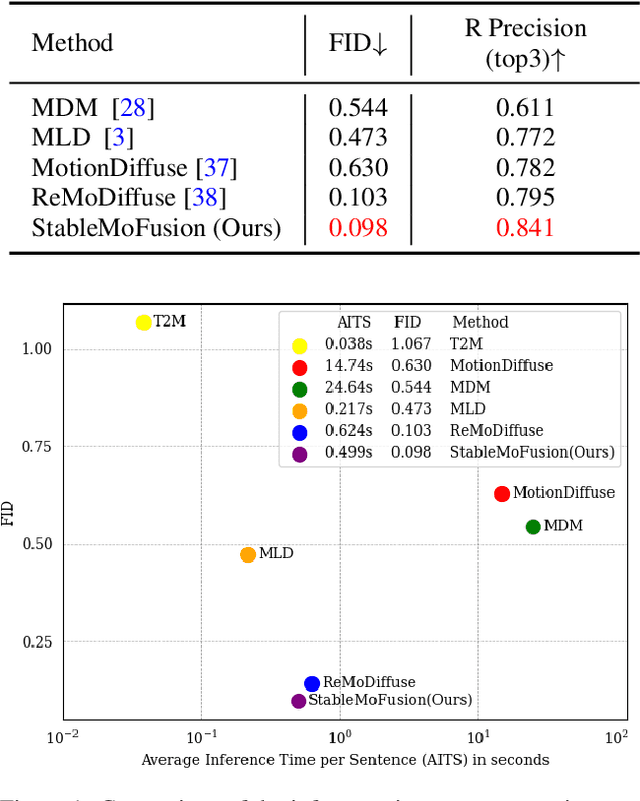
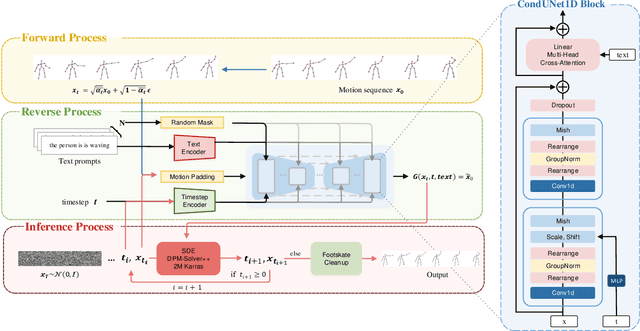
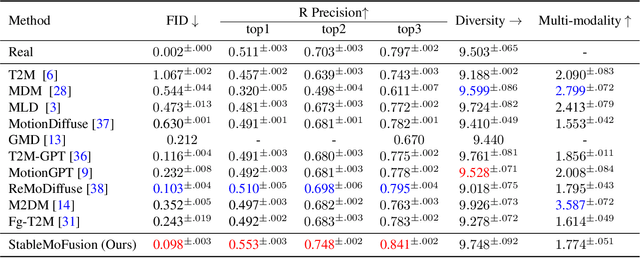
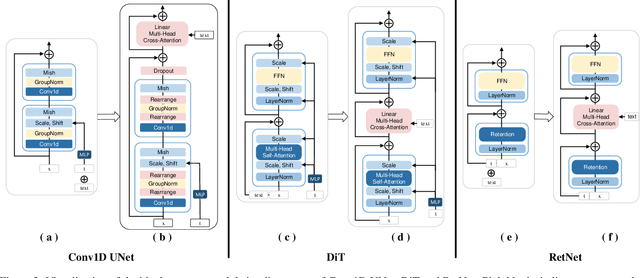
Abstract:Thanks to the powerful generative capacity of diffusion models, recent years have witnessed rapid progress in human motion generation. Existing diffusion-based methods employ disparate network architectures and training strategies. The effect of the design of each component is still unclear. In addition, the iterative denoising process consumes considerable computational overhead, which is prohibitive for real-time scenarios such as virtual characters and humanoid robots. For this reason, we first conduct a comprehensive investigation into network architectures, training strategies, and inference processs. Based on the profound analysis, we tailor each component for efficient high-quality human motion generation. Despite the promising performance, the tailored model still suffers from foot skating which is an ubiquitous issue in diffusion-based solutions. To eliminate footskate, we identify foot-ground contact and correct foot motions along the denoising process. By organically combining these well-designed components together, we present StableMoFusion, a robust and efficient framework for human motion generation. Extensive experimental results show that our StableMoFusion performs favorably against current state-of-the-art methods. Project page: https://h-y1heng.github.io/StableMoFusion-page/
QAGait: Revisit Gait Recognition from a Quality Perspective
Jan 24, 2024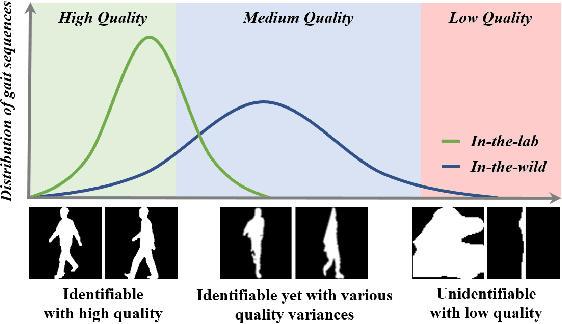
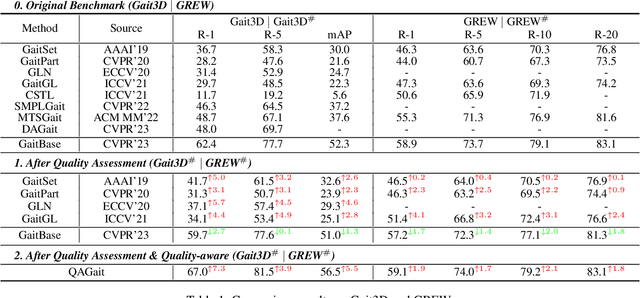

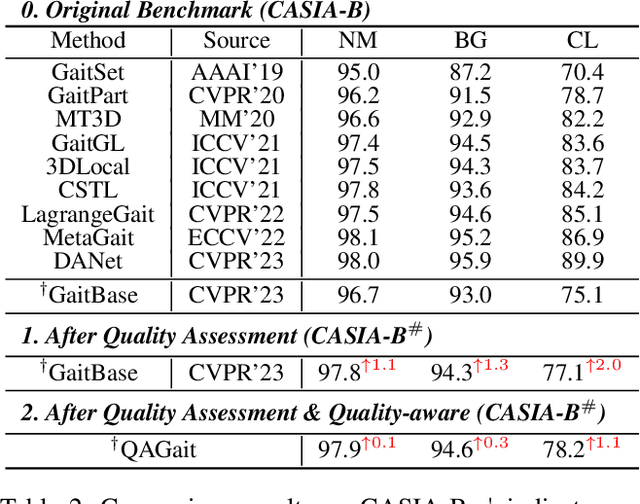
Abstract:Gait recognition is a promising biometric method that aims to identify pedestrians from their unique walking patterns. Silhouette modality, renowned for its easy acquisition, simple structure, sparse representation, and convenient modeling, has been widely employed in controlled in-the-lab research. However, as gait recognition rapidly advances from in-the-lab to in-the-wild scenarios, various conditions raise significant challenges for silhouette modality, including 1) unidentifiable low-quality silhouettes (abnormal segmentation, severe occlusion, or even non-human shape), and 2) identifiable but challenging silhouettes (background noise, non-standard posture, slight occlusion). To address these challenges, we revisit gait recognition pipeline and approach gait recognition from a quality perspective, namely QAGait. Specifically, we propose a series of cost-effective quality assessment strategies, including Maxmial Connect Area and Template Match to eliminate background noises and unidentifiable silhouettes, Alignment strategy to handle non-standard postures. We also propose two quality-aware loss functions to integrate silhouette quality into optimization within the embedding space. Extensive experiments demonstrate our QAGait can guarantee both gait reliability and performance enhancement. Furthermore, our quality assessment strategies can seamlessly integrate with existing gait datasets, showcasing our superiority. Code is available at https://github.com/wzb-bupt/QAGait.
FurniScene: A Large-scale 3D Room Dataset with Intricate Furnishing Scenes
Jan 07, 2024Abstract:Indoor scene generation has attracted significant attention recently as it is crucial for applications of gaming, virtual reality, and interior design. Current indoor scene generation methods can produce reasonable room layouts but often lack diversity and realism. This is primarily due to the limited coverage of existing datasets, including only large furniture without tiny furnishings in daily life. To address these challenges, we propose FurniScene, a large-scale 3D room dataset with intricate furnishing scenes from interior design professionals. Specifically, the FurniScene consists of 11,698 rooms and 39,691 unique furniture CAD models with 89 different types, covering things from large beds to small teacups on the coffee table. To better suit fine-grained indoor scene layout generation, we introduce a novel Two-Stage Diffusion Scene Model (TSDSM) and conduct an evaluation benchmark for various indoor scene generation based on FurniScene. Quantitative and qualitative evaluations demonstrate the capability of our method to generate highly realistic indoor scenes. Our dataset and code will be publicly available soon.
Spectral Prompt Tuning:Unveiling Unseen Classes for Zero-Shot Semantic Segmentation
Dec 20, 2023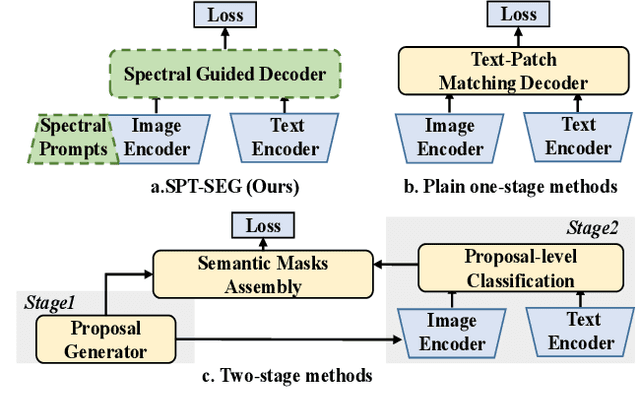
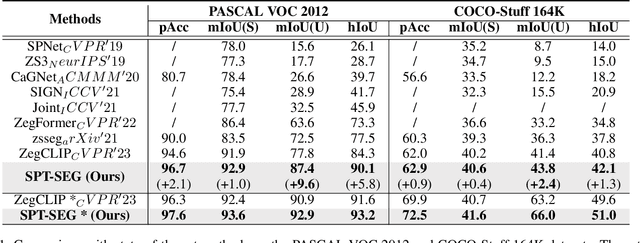
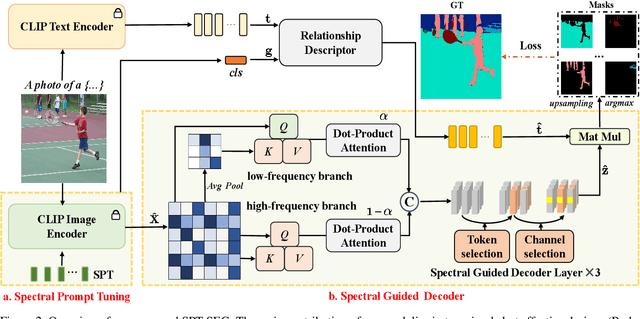
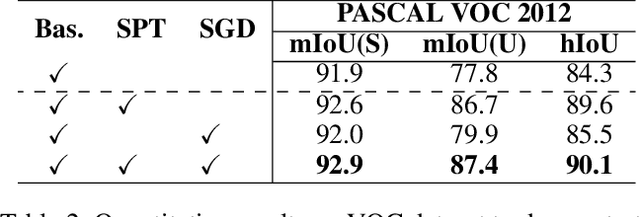
Abstract:Recently, CLIP has found practical utility in the domain of pixel-level zero-shot segmentation tasks. The present landscape features two-stage methodologies beset by issues such as intricate pipelines and elevated computational costs. While current one-stage approaches alleviate these concerns and incorporate Visual Prompt Training (VPT) to uphold CLIP's generalization capacity, they still fall short in fully harnessing CLIP's potential for pixel-level unseen class demarcation and precise pixel predictions. To further stimulate CLIP's zero-shot dense prediction capability, we propose SPT-SEG, a one-stage approach that improves CLIP's adaptability from image to pixel. Specifically, we initially introduce Spectral Prompt Tuning (SPT), incorporating spectral prompts into the CLIP visual encoder's shallow layers to capture structural intricacies of images, thereby enhancing comprehension of unseen classes. Subsequently, we introduce the Spectral Guided Decoder (SGD), utilizing both high and low-frequency information to steer the network's spatial focus towards more prominent classification features, enabling precise pixel-level prediction outcomes. Through extensive experiments on two public datasets, we demonstrate the superiority of our method over state-of-the-art approaches, performing well across all classes and particularly excelling in handling unseen classes. Code is available at:https://github.com/clearxu/SPT.
The Development of LLMs for Embodied Navigation
Nov 18, 2023



Abstract:In recent years, the rapid advancement of Large Language Models (LLMs) such as the Generative Pre-trained Transformer (GPT) has attracted increasing attention due to their potential in a variety of practical applications. The application of LLMs with Embodied Intelligence has emerged as a significant area of focus. Among the myriad applications of LLMs, navigation tasks are particularly noteworthy because they demand a deep understanding of the environment and quick, accurate decision-making. LLMs can augment embodied intelligence systems with sophisticated environmental perception and decision-making support, leveraging their robust language and image-processing capabilities. This article offers an exhaustive summary of the symbiosis between LLMs and embodied intelligence with a focus on navigation. It reviews state-of-the-art models, research methodologies, and assesses the advantages and disadvantages of existing embodied navigation models and datasets. Finally, the article elucidates the role of LLMs in embodied intelligence, based on current research, and forecasts future directions in the field. A comprehensive list of studies in this survey is available at https://github.com/Rongtao-Xu/Awesome-LLM-EN
 Add to Chrome
Add to Chrome Add to Firefox
Add to Firefox Add to Edge
Add to Edge